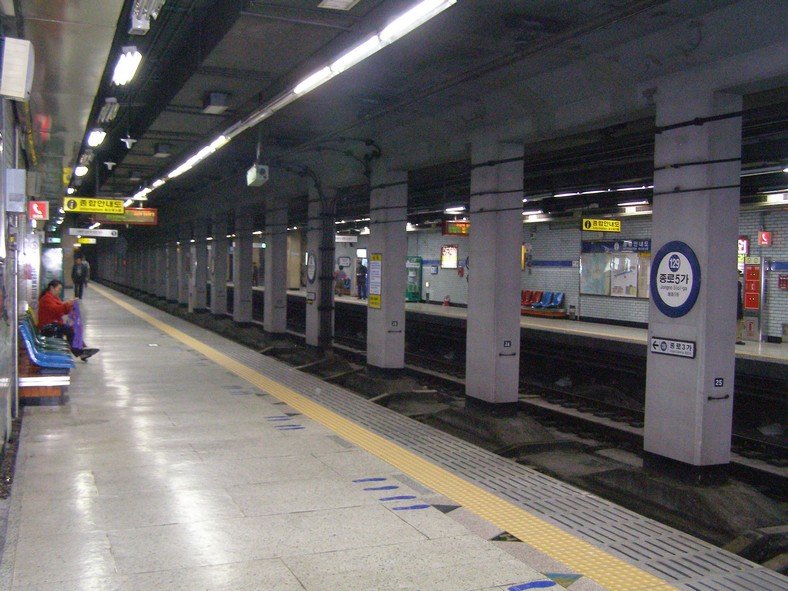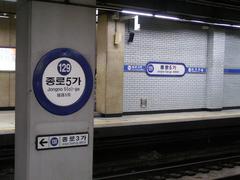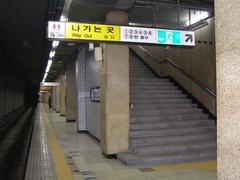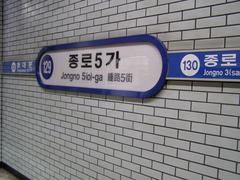
Jongno 5-Ga Station: Visiting Hours, Tickets, and Travel Guide
Date: 14/06/2025
Introduction
Jongno 5-Ga Station serves as a vibrant entry point into the historical and cultural heart of Seoul. Nestled in one of the city’s most storied districts, the station is an excellent starting point for exploring palaces, shrines, bustling traditional markets, and scenic urban spaces that illustrate the dynamic interplay between Korea’s past and present. The surrounding Jongno district, historically known as “Bell Street,” has been a key artery since the Joseon Dynasty, connecting royal palaces, Confucian shrines, and commercial hubs. Today, Jongno 5-Ga Station on Seoul Subway Line 1 not only acts as a critical transportation hub but also provides direct access to UNESCO-listed sites like Jongmyo Shrine, the energetic Gwangjang Market, and the revitalized Cheonggyecheon Stream.
This guide delivers comprehensive information on visiting hours, ticketing, travel options, accessibility, nearby attractions, and practical tips, ensuring you enjoy a seamless and enriching experience in Seoul’s historic core. For official updates and further resources, consult the Seoul Cultural Heritage Website and Visit Seoul.
Table of Contents
- Introduction
- Historical Context of Jongno 5-Ga Station and Area
- Major Cultural Landmarks
- Practical Visitor Information
- Local Festivals and Traditions
- Arts, Religion, and Museums
- Heritage Preservation and Urban Modernization
- Travel Tips
- Frequently Asked Questions
- Conclusion
- Sources
Historical Context of Jongno 5-Ga Station and Area
Jongno 5-Ga Station sits beneath Jongno, one of Seoul’s oldest thoroughfares, dating back to the Joseon Dynasty (1392–1897). This district has long been central to the city’s political, commercial, and cultural development. Historically, Jongno connected city gates and served as Hanyang’s (old Seoul’s) main east-west corridor. The establishment of the subway station in the 20th century reinforced Jongno’s status as a gateway between tradition and modernity, welcoming visitors to explore the city’s distinguished heritage.
Major Cultural Landmarks
Jongmyo Shrine
A 10-minute walk from Jongno 5-Ga Station, Jongmyo Shrine is Korea’s most significant Confucian royal shrine and a UNESCO World Heritage Site. Built in 1394, it enshrines the spirits of Joseon Dynasty kings and queens. The site is famed for the Jongmyo Jerye ritual, an annual ancestral ceremony featuring traditional music, which is recognized as Intangible Cultural Heritage by UNESCO.
- Hours: 9:00 AM–6:00 PM (March–October); 9:00 AM–5:30 PM (November–February). Closed Mondays and major holidays.
- Admission: 1,000 KRW (adults), 500 KRW (youth/seniors), free for children under 7.
- Guided Tours: Available in multiple languages; advance booking recommended.
- Seoul Cultural Heritage Website
Gwangjang Market
Just five minutes from the station, Gwangjang Market is one of Korea’s oldest traditional markets, established in 1905. It’s celebrated for authentic Korean street food like bindaetteok (mung bean pancakes), mayak gimbap (mini seaweed rolls), and yukhoe (beef tartare).
- Hours: 8:30 AM–6:00 PM (market), some food vendors until 11:00 PM; closed Sundays.
- Admission: Free; food prices vary by vendor.
- Gwangjang Market Information
Cheonggyecheon Stream
A short walk from Jongno 5-Ga Station, Cheonggyecheon Stream is a 10.9-kilometer-long urban renewal project with walkways, art installations, and night illuminations.
- Hours: Open 24/7; no admission fee.
- Cheonggyecheon Stream
Bukchon Hanok Village and Insadong
Accessible by subway or a 15-minute walk, Bukchon Hanok Village features hundreds of preserved hanok (traditional Korean houses) and offers cultural experiences like hanbok rentals and tea ceremonies. Insadong, nearby, is renowned for its antique shops, art galleries, and tea houses.
Practical Visitor Information
Station Details and Accessibility
- Subway Line: Seoul Metro Line 1
- Accessibility: Elevators, tactile paving, accessible restrooms
- Tickets: Single journey from 1,350 KRW; Tmoney cards accepted
Tickets and Transportation
- Subway: Operating from 5:30 AM to midnight. Use Tmoney cards or purchase tickets at kiosks.
- Bus: Blue, green, and yellow buses serve the area.
- Taxi: Readily available; metered fares start at 3,800 KRW.
- Cycling: Ddareungi public bikes available nearby.
Guided Tours and Events
- Jongmyo Shrine: Official guided tours in multiple languages.
- Seasonal Events: Jongmyo Daeje (May), Seollal, and Chuseok celebrations.
Photo Spots
- Jongmyo Shrine’s main hall and gardens
- Gwangjang Market’s bustling food stalls
- Cheonggyecheon’s illuminated nightscapes
- Bukchon Hanok rooftops
Accommodations
From guesthouses to hotels, options are plentiful in Jongno-gu and Insadong, catering to various budgets.
Local Festivals and Living Traditions
Jongmyo Daeje, the royal ancestral ritual held annually in May, is a must-see, offering a vivid display of Korea’s intangible heritage. The area also hosts art fairs, night markets, and traditional festivities throughout the year.
Arts, Religion, and Museums
Jongno 5-Ga is home to Jogyesa Temple, the heart of Korean Zen Buddhism, as well as Confucian academies and Christian churches. Insadong offers access to the Alive Museum, contemporary galleries, and the National Folk Museum, providing a window into Korea’s artistic and cultural legacy.
Heritage Preservation and Modernization
The district exemplifies the balance between maintaining historical identity and embracing urban innovation. Restoration projects, incentives for artisans, and tourism initiatives ensure that tradition and modern life coexist harmoniously.
Travel Tips
- Best Time to Visit: Spring (April–June) and autumn (September–November)
- Getting Around: Use Tmoney for convenience; navigation apps like KakaoMap are helpful
- Language: Basic English signage is common; translation apps recommended
- Dress Code: Dress modestly when visiting shrines and temples
- Safety: Seoul is safe, but keep an eye on personal belongings in crowded places
Frequently Asked Questions (FAQ)
Q: What are the visiting hours for key attractions?
A: Jongmyo Shrine: 9:00 AM–6:00 PM (March–October), 9:00 AM–5:30 PM (November–February), closed Mondays. Gwangjang Market: 8:30 AM–6:00 PM, some food stalls until 11:00 PM, closed Sundays. Cheonggyecheon Stream: Open 24/7.
Q: How do I buy transportation tickets?
A: At subway kiosks or with a rechargeable Tmoney card, available at stations and convenience stores.
Q: Is the station accessible for wheelchairs?
A: Yes, Jongno 5-Ga Station and most nearby attractions are wheelchair accessible.
Q: Are guided tours available in English?
A: Yes, at Jongmyo Shrine and via local tour operators for other sites.
Q: Can I use Tmoney on buses and taxis?
A: Yes, Tmoney cards work on Seoul’s subways, buses, and most taxis.
Conclusion
Jongno 5-Ga Station is more than a transit hub—it’s your portal into Seoul’s profound cultural tapestry, offering easy access to historic shrines, vibrant markets, tranquil streams, and living traditions. With excellent transportation, diverse attractions, and modern amenities, it’s an ideal starting point for any visitor eager to delve into Seoul’s rich heritage. Use this guide to plan your journey and enjoy an authentic experience at the city’s historic heart.
Ready to explore Seoul? Download the Audiala app for real-time updates, guided tours, and exclusive travel tips. Follow us on social media for the latest on Seoul’s hidden gems!
Sources
- Jongno 5-Ga Station: Visiting Hours, Tickets, and Exploring Seoul’s Historic Sites, 2025, Cultural Heritage Administration (http://english.cha.go.kr/)
- Discover Jongmyo Shrine: Seoul’s Historic Royal Ancestral Monument, 2025, Seoul Cultural Heritage Website (http://english.cha.go.kr)
- Transportation and Nearby Attractions at Jongno 5-Ga Station: Your Guide to Seoul’s Historic Hub and Gwangjang Market, 2025, Visit Seoul (https://english.visitseoul.net/transportation)
- Discover Jongmyo Shrine: History, Visiting Tips, and Nearby Attractions, 2025, The Tourist Checklist (https://thetouristchecklist.com/gwangjang-market/)
- Gwangjang Market Information, 2025, Visit Seoul (https://english.visitseoul.net/shopping/Gwangjang-Market_/68)















































































































































































































